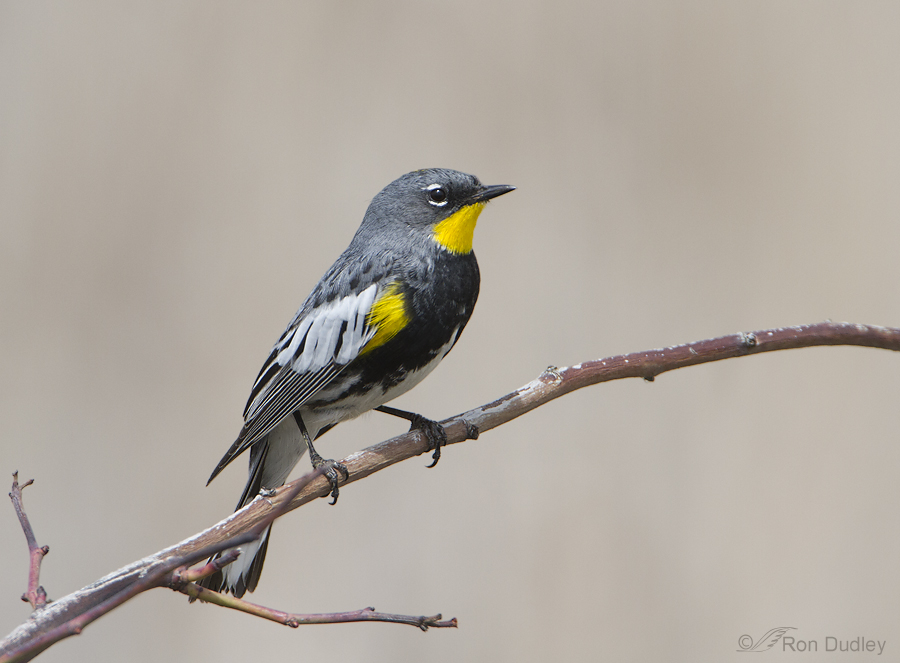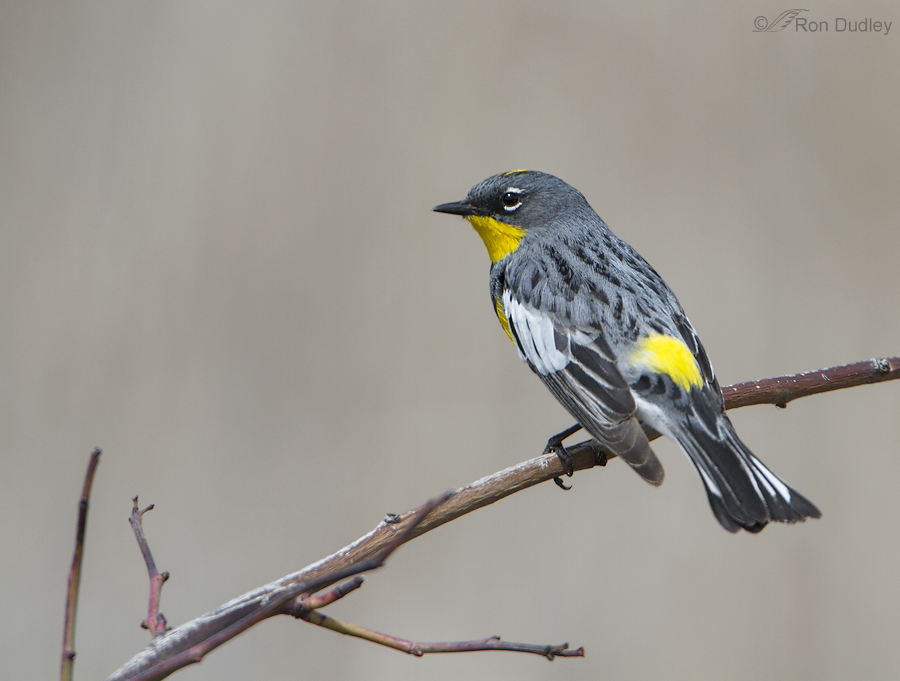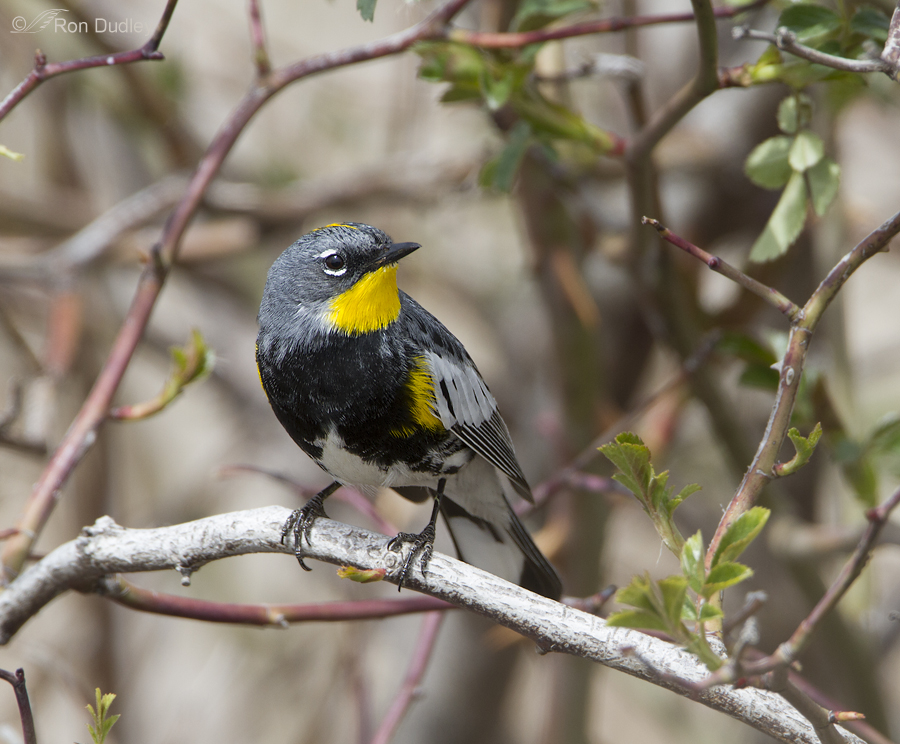There’s no denying that songbirds tend to be short-shrifted on my blog. That wasn’t a conscious decision on my part but it’s sure the way things have turned out. This post is an initial effort to attempt rectify the situation.
The pretty little Yellow-rumped Warbler is one of the most common warblers in North America so I thought this species was a good place to start.
1/1600, f/6.3, ISO 400, 500 f/4, 1.4 tc, natural light
There are two sub-species of Yellow-rumped Warblers – Myrtle Warbler in eastern North America and Audubon’s Warbler of the western part of the continent. This is the Audubon’s subspecies, as identified by the yellow throat (white throat on Myrtle). Audubon’s and Myrtle were long considered to be separate species but when it was discovered that they hybridize in the Canadian Rockies they were combined into a single species.
1/1250, f/6.3, ISO 400, 500 f/4, 1.4 tc, natural light
This pose shows off that distinctive yellow rump. These birds are often affectionately called “butter-butt” for obvious reasons.
These first two “bird on a stick” images are rather sterile but they give a good look at the bird.
1/640, f/6.3, ISO 400, 500 f/4, 1.4 tc, natural light
They’re much more often found buried deeply “in habitat” as you see here, which can make for a more cluttered setting but often has a more natural appeal.
The preferred habitat of the Yellow-rumped Warbler is one of the most ecologically generalized of all warblers, which partially accounts for its broad range. During the nonbreeding season it can be found in almost any habitat. One example of its adaptability among warblers is the fact that they’re the only warbler species able to digest the waxes in bayberries, which has allowed them to winter in coastal areas as far north as Nova Scotia.
Ron





Ron,
Thanks to your post, I’m pretty sure this is the beautiful little bird I’m seeing in one of my Ocotillos this morning.
So excited to finally see these up close! I live in SW Washington state, and a couple years ago, a large flock of these invaded my maple tree. They were gone completely about 2 weeks later, and in that time they dwindled to just a few stragglers. I couldn’t get close enough to see them clearly. This year I saw them in another yard, and was able to get a good look. They just come through here in early – mid spring apparently. Pretty, fun to watch, and now I know what they are!
Thank you so much for the sound link. Loved it.
Pretty little things. Is their song equally so? (And I love the butter-butt moniker.)
Elephant’s Child, the song of the male has been described as “a slow, soft, sweetly whistled warble or trill”.
Here’s a link to 3 sound files if you’re interested. http://www.allaboutbirds.org/guide/Yellow-rumped_Warbler/sounds
I love the colors! Ron, what do you recommend for shooting these little songbirds? I know my own frustrations from trying to shoot these. Do you think the backyards feeders help? I know one of my first Bananaquit shots was made with the help of a resident who simply had a cup of sugar out in his balcony. For this reason, there were many Bananaquits in his front porch, so he let me shoot away. But if this cup of sugar had not been there, I would have not been able to get as close. They are hardly 3″ long.
Aside from this, what do you think of the Hummingbird secret for shooting them in flight? Some of these ‘Hummingbird Pros’ give workshops, but the set-up is so time consuming and costly. Some of them reveal their method quite candidly. I am quite intrigued by this issue, since I’ve missed great opportunities to shoot them.
Maria, I don’t think feeders would help with most warblers as they’re mostly gleaners of insects.
Personally, shooting birds at “set-ups” of any kind (including feeders) just doesn’t appeal to me. I consider myself to be a “nature” photographer and shooting setups where everything has been manipulated just doesn’t cut it for my purposes. I do keep feeders in my back yard but the only time I photograph birds there is for the practice and to help develop my skills. I’m not passing judgement on what others do but that’s what works for me.
I don’ know why they call the Bananaquit a warbler; it’s also called a Honeycreeper. It’s into the nectar business. All I know that is that I shot it from a community that flew around this man’s home. It wasn’t baited at the time I shot it, but the feeder probably kept the community there.
I’m with Tana– “butter butt”!! I never heard that and I love it. Based on the song, I have them in my back yard right now, but I guess I need glasses… all small birds farther than 8 feet away look similar against the light Thanks for giving us a songbird! And thanks for the answer about the Shoveler Attack — if one were watching, one would certainly miss the whole thing– digital photography, wow gotta love it.
Thanks for giving us a songbird! And thanks for the answer about the Shoveler Attack — if one were watching, one would certainly miss the whole thing– digital photography, wow gotta love it.
You’re very welcome on both counts, Chris.
Nice shots. I think your Audubon’s subspecies is a little prettier than the Myrtles we get here. I saw one in Texas–pretty fun.
Scott, I’ve yet to see a Myrtle.
Beautiful photography of a bird which sure brightens up the forest, swamp or back yard.
Thank you, Wally.
Hi Ron,
Your pictures as always are superb. What makes your blog special is the knowledge of birds you share with your great pictures.
Thank you for a wonderful blog.
Len
I’m glad you appreciate the little bits of factual info, Len. Thanks for letting me know.
You keep posting; I’ll keep learning. Your photos are so nice and I love getting one every day!Thank you making it a little brighter.
I’ll do the posting and we’ll BOTH do some learning, Diana.
ButterButts! I haven’t heard that before but now I will not be able to call them anything else. Wonderful shots of a beautiful welcome visitor to my yard. Thank you for this cold morning bit of sunshine!
Yean, it’s kind of a catchy moniker for them, isn’t it, Tana?
Amazing detail!
Thanks, Mike.